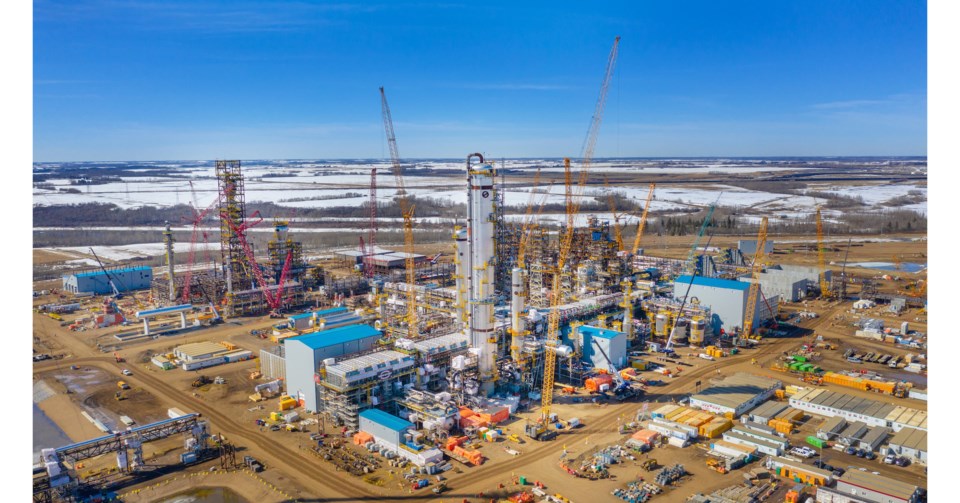A shift is taking place in Alberta’s industrial heartland as the province’s economy builds on the success of its petrochemical processing sector towards other energy sources and new manufacturing ventures.
“We have a team of people inside our shop, that when they’re looking at promoting project opportunities, they’re having conversations around biofuels or solar farms or critical mineral refining,” said Mark Plamondon, executive director of Alberta’s Industrial Heartland Association. “It’s a significant diversification away from the historical oil upgrading and refining projects.”
Plamondon’s group came together in 1998 as an initiative of local governments in Fort Saskatchewan, Lamont County, Strathcona County and Sturgeon County. Edmonton joined in 2010, bringing the total industrial land within the association’s catchment area to 582 square kilometres (143,815 acres). Approximately 75 per cent, all of it pre-zoned for industrial use, is available for development.
“From a land position, there’s lots of land,” Plamondon said.
Concentrated in Strathcona and Sturgeon counties, the parcels are scattered across the region rather than forming a single contiguous block. The cluster also anchors allied sectors outside the formal geographic boundaries, meaning it punches above its weight on the national scale. It ranks as the largest, most competitive petrochemical cluster in Canada. Sarnia ranks second, but a 2021 study for the Chemistry Industry Association of Canada notes that Sarnia is less competitive on most counts except its proximity to U.S. markets.
By contrast, Alberta’s industrial heartland outscores Sarnia in terms of electricity costs, integration with processors and waste management. This has attracted more than $45 billion in capital investment since the 1950s.
The most recent project was Calgary-based Inter Pipeline Ltd.’s polypropylene facility, completed last year in Strathcona County. The plant takes advantage of low-cost propane feedstock to produce up to 525,000 tonnes a year of polypropylene, a high-value, multi-use recyclable plastic – the only plant in Canada to do so, and first new plant in North America in a decade.
Rail networks offering connections to West Coast ports and the U.S., made it an ideal location. Provincial government support, including attractive incentives, also supported Inter Pipeline’s decision.
“The tremendous amount of low-cost feedstocks (natural gas liquids, in particular) has really created a significant competitive advantage to continue to grow the petrochemical space,” Plamondon said of developments over the past five to seven years. “You’re continuing to grow the range of products that come out of the industrial heartland, which makes the region more resilient to economic gyrations.”
With the Alberta economy recovering its mojo post-pandemic, interest is cruising at record highs.
“Right now is a fairly busy time coming out of COVID, that companies are looking to advance their capital projects, so a lot of companies [are] looking at the industrial heartland,” he said.
Strong environmental credentials relative to other regions adds to the appeal. Alberta’s petrochemical sector regularly receives high marks on environmental, social and governance measures, while the exploration and production sides are building on the 10 per cent reduction in greenhouse gas emissions logged between 2000 and 2019.
Air Products Canada’s plans for a $1.3-billion plant to supply the region with hydrogen-fuelled electricity and liquid hydrogen for vehicles as early as 2024 adds to the lustre. The plant will also sequester carbon from processing, reducing the sector’s downstream emissions.
“It helps produce a lower-carbon hydrogen product and it actually helps the decarbonization of other industrial facilities in the region,” Plamondon said. “It’s positioning this region to be a growth engine for the future as companies around the world are looking to produce lower-carbon products.”
Calgary region
The heartland’s shift towards value-added manufacturing is also taking place in the industrial precincts surrounding Calgary. Red-hot demand for distribution space pushed the Calgary industrial market to its best year ever last year, according to CBRE Ltd., but massive investments by major manufacturers are diversifying activity.
During the latter half of 2022, wallboard producer CGC Inc. and aircraft manufacturer De Havilland Canada announced investments in Wheatland County supported by Invest Alberta Corp.
A recent market outlook from CBRE Ltd. indicates that last year was the best year ever for Calgary industrial, and this is expected to continue into the first half of 2023 for many of the same reasons as Edmonton: a central location and lower cost base relative to other markets.
The industrial development is supporting other investments, too.
The proposed Green Line LRT extension in Calgary will run through several industrial areas in southeast Calgary making it easier for workers to access both established and newly emerging areas. Built on a hub-and-spoke model, bus connections will radiate out from each new LRT station.
Ogden station, for example, sits adjacent to the CPR headquarters and railyards, while Highfield and Shepard will serve the clusters of industrial development surrounding them.
“The whole southeast side of Calgary is grossly underserved by transit,” says Wendy Tynan, executive director, stakeholder relations and communications with the Green Line LRT project for the city. “[The Green Line] will actually give people working in industrial areas opportunities for transit and making it more accessible for people to get there.”



